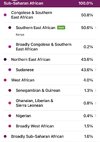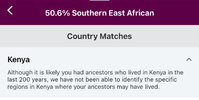Wow, once again, thank you for how thorough you always are with this information. I know just researching and looking back at all the sources you've gathered over the years takes time out of your day, so I'm definitely very grateful for that. Sorry for not responding sooner, I just have a horrible habit of completely forgetting about the site each time I reply. But I really do appreciate it. In the periods where I am on the site, I often look back over even your oldest replies and the previous information you've shared with me. Especially as I build my pool of knowledge on this topic over time as well, so there a things you've said that I might not have really grasped upon previous reads that will suddenly make sense to me at a later time. So even though this thread spans across so many replies and such a long time, I'm still always learning from even what you've shared long ago.
It's all good. As long as you read what I write.
Also, I got a match for Kenya on 23AndMe with an update late last year, so that I'm thinking might tie into that theory of my MtDNA, although I do appreciate that you've said previously not to really give 23AndMe too much stock as far as their ethnicity breakdowns when it comes to most Africans. And more than likely it's probably just due to the Luo population there that I imagine I match super closely with and probably have a few distant relatives within. Regardless, I was still super keen to see an actual country match though lol, as I never had one prior.
You should send a non-creepy private message to inquire directly.
By the way, if you don't mind me asking, what are the actual implications of someone who receives a very detailed ethnicity breakdown from 23AndMe, sometimes even down to the city and beyond, vs someone like me who has just a lot of general regions. Which I'm sure the latter is actually the norm anyway. But so for example, someone who receives an ethnicity breakdown right down to their parents' ethnic groups. The only variable that really jumps out at me right now, and probably the most obvious, is sample size. Because of course naturally, if there are less samples overall for a particular region/group, it'd be virtually impossible to confidently tie anyone with them. What do either of these things usually say about someone's genetic makeup, their ethnic group, etc? Are there any other things that might factor into this?
People who get regions indeed get it through sample size and reported familial origin. The designation by 23andMe users of where their grandparents are from, and what ethnic group they belong to is very important to fixing sub-structure to geographic region, overtime when the sample size grows, statistical measures can widen spatial-genetic resolution.
It's a bit more methodological. They use the data they have to train the system to set parameters, with new users then fitting into that, and/or bettering the needed calibration as well. Yes, they used machine learning for this. Because they use aggregate systems recognition through PCA and a fancy process they call "Uniform manifold approximation and projection," which is basically a way to average clusters into uniform placements, they can conceptually build relational and associative landscapes for genetics to fit dimensions. Added with this: "which, when paired with survey data and analyzed jointly with the well-curated external reference panels, enabled us to define our 45 reference populations and flag outliers for removal" as mentioned in their White Paper, they can reliably build a well-functioning system. They use additional signifiers that also goes beyond geography sometimes, "Free-text responses on grandparental national, ethnic, religious, or other identities enabled us to construct reference panels for populations not defined by specific geographic regions (e.g., Ashkenazi Jews)."
The fact of the matter is, that Sudanese populations are very undertested. Kenyan population has formal studies that were used to define the parameters, so they are already in a better position. But I have seen northern Sudanese barely get different scores from South Sudanese for the majority of their ancestry which is weird. Clearly, this is caused by a lack of data streams through the user base and a dearth of formal studies used.
So they can ascertain "Kenya", within the broader Southern East African or "Oromo region" within Ethiopia and Eritrea because they have stronger associative power to fix substructure relations to those places for aspects of the ancestry base of an individual. This Kenyan individual is for sure from Kenya and carries ancestry specifically acquired in the historical Kenyan population gene flow.
If this person has Luo from the Kenyan side, then the very high Sudanese can be that they received recent ancestry from somewhere you're from. As far as I know, if the Kenyan is not strictly limited to someone with high Bantu ancestry, then that individual should be more Nilo-Saharan than the average Luo Kenyan.
I don't remember exactly what 23andMe said about your ancestry, but I think it might be more accurate than what a Nubian would score, lol. Sometimes people might get "Khartoum" as an indication of the Nubian ancestry. That is a very loose term.
One study claimed that riverine Arabs and Nubians related more along geography instead of ethnic group. What amounts to shifts is a proximal thing as I know most Nubians and riverine Arabs carry most of the same type of substructure, with fluctuating values. So althoguh the study was right, it could not mean a Nubian in Wadi Halfa is considerably different than an individual from Central Sudan. We do have samples that debunk this.



